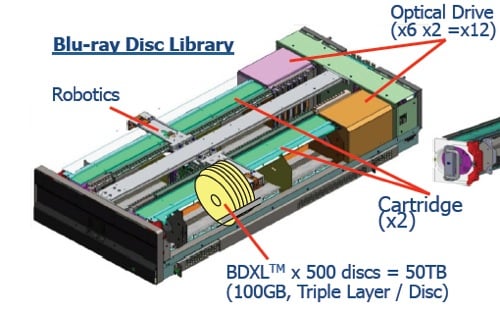This article is more than 1 year old
Sony sees the cold light of optical archives, buys ex-Facebooker's upstart
Tech giant hopes new acquisition will solve its data jukebox problems
Blinded by the light
Optical archives have not taken off in the past because costs were higher than tape while throughput – although lower latency (random access) – did not offer enough speed-up or capacity per disk compared to tape reels. That latter point meant that optical archives did not offer enough of a saving in data centre floor space over tape.
Blu-ray disks have to be mounted in a drive and libraries store disks in shelves, with a robot picking them up and bringing them to a drive. How does the product builder maximise disk packing density while having enough space in the box for a robot to pick and move disks to and from drives, while also maximising the speed of the robotics? It’s the classic tape and disk library problem.
Blu-ray’s roadmap helps solve the capacity issue, and hence space. Frankovsky must have technology ideas to overcome the throughput, disk packing density and robotics issues, which Sony needs for its Blu-ray technology.
If he doesn’t, then this could be yet another doomed optical archive jukebox jamboree.
HDS was looking into optical archive technology a couple of years ago. Nothing much has been heard since from its HLDS operation.

HLDS optical archive technology
Lurking in the technology wings is the prospect of archives using 3D/TLC flash drives, if the flash boys can get media cost down low enough and data longevity high enough. Access speed would trump both disk and tape and power costs ought to be way lower than either. Packing density should trump everything else too. But this is a technology-in-waiting, while Blu-ray is here now.
With Sony-OAI we’re looking at a kind of Blu-ray-based archive rack, possibly with file metadata held on disk or in flash, improved rack space utilisation to make the comparison with tape look better and faster throughput – meaning time to mount the drive and time to first data access.
The Sony-OAI box has to move nearer to disk for speed, and nearer to and potentially past tape for cost and space-efficiency. It’s a big ask. ®
